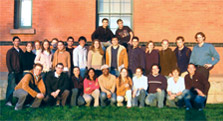

Cornell's team benefited from interdisciplinary cooperation.

The Cornell house's crystalline-silicon PV panels power a heat pump and home electrical needs.
Solar Decathlon 2005
Cornell University
Wheel of Comfort
"We were not going to design just for the competition," says architecture graduate student Ben Uyeda. "Because we wanted the home to be a sound investment for the buyer, we made it modular so that homeowners could add to it as needed and as they could afford it." An overarching goal for the Cornell Solar Decathlon team was to create a home, or set of home designs actually, that could be mass-produced.
"We designed alternate versions, such as one for the cold winters back here in Ithaca, but made sure each complied with HUD guidelines for manufactured housing," points out architecture student Stephanie Horowitz. The team's goal was to create an affordable house that could sell for $50,000 to $100,000.
The Cornell house features a custom-designed energy recovery ventilator (ERV). ERVs are very effective at reducing the additional energy load for ventilation. To maintain healthy indoor air quality, adequate ventilation is necessary. The problem with good ventilation, however, is that it takes a lot of energy to heat cold, winter air or to cool and dehumidify hot, humid summer air.
The key component of Cornell's ERV is a rotary wheel composed of silica gel—the same material used in the little packets found inside food and other packaging. In summer, for example, the silica gel absorbs humidity from the fresh air intake before it reaches the air handler. It is then wheeled around to be regenerated, transferring the humidity to the exhaust along with extracted heat. This preconditioning can dramatically reduce the energy consumption of the heating and cooling system.
Of all the innovative technologies in the home, "I am most proud of the ERV and the control system we developed for it," says Tim Fu, mechanical engineering grad student.
Control systems are another technical highlight of the Cornell entry, with systems designed to make it "very much a smart house," says Uyeda. Everything will be controlled automatically, but can also be adjusted by the occupants, with manual-override touch screen controls in several places. Heating and cooling beyond that provided by the ERV is by forced air from an electric heat pump. An evacuated-tube solar thermal system provides domestic hot water. Power for the heat pump and home electrical needs comes from a set of crystalline-silicon PV panels. General Electric donated all the PV panels and most of the home appliances—all Energy Star—under a full sponsorship arrangement for the Cornell Decathlon home.
Team Contact
Prof. Zellman Warhaft
Cornell University
244 Upson Hall
Ithaca, NY 14850
607-255-3898
